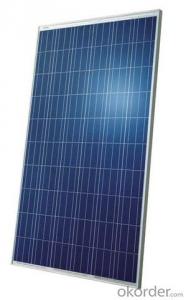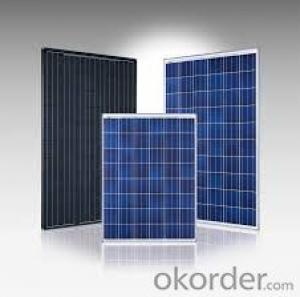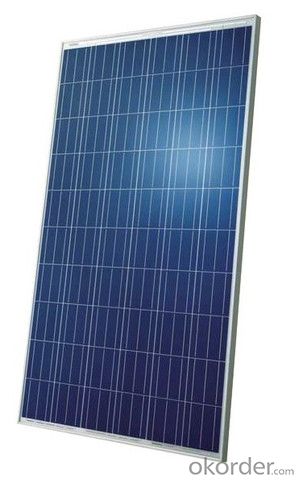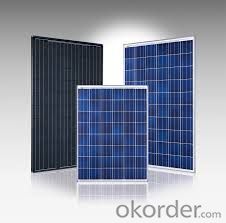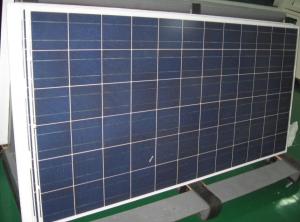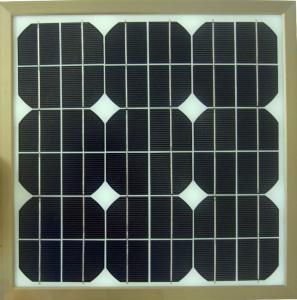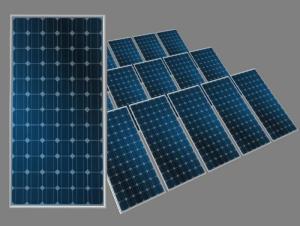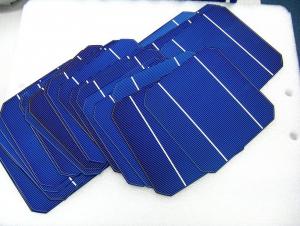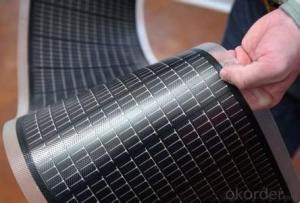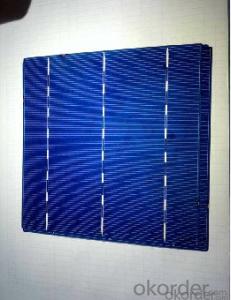Pre-Tabbed Solar Cells Factory Direct Sale Polycrystalline Solar Panel CNBM
- Loading Port:
- Qingdao
- Payment Terms:
- TT OR LC
- Min Order Qty:
- 10 set
- Supply Capability:
- 300000 set/month
OKorder Service Pledge
OKorder Financial Service
You Might Also Like
Polycrystalline Solar Modules
CNBM offers a range of small, medium and large polycrystalline solar modules, designed for a range of requirements.
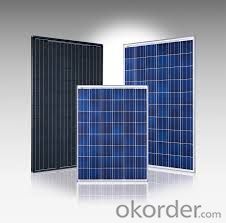
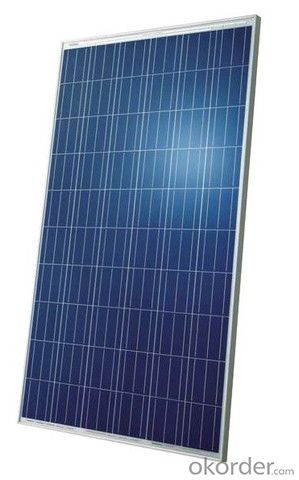
Specifications:
Tolerance | +/-3% |
Cell | Polycrystalline silicon solar cells (156 x 156mm) |
N0. of Cells | 60 (10 x 6) |
Dimension of Modules (mm) | 1650 x 990 x 40 |
Weight (kg) | 25.5 |
Limits:
Operating Temperature | -40~+85? |
Storage Temperature | -40~+85? |
Maximum System Voltage | 1000 VDC max. |
Hail Impact | Diameter of 28mm with impact speed |
Temperature and Coefficients:
NOCT | 48C+/-2? |
Voltage temperature coefficient (%/K) | -0.35 |
Current temperature coefficient (%/K) | 0.05 |
Power temperature coefficient (%/K) | -0.45 |
Characteristics:
Model: | SGM-200P | SGM-210P | SGM-220P |
Max-power voltage Vmp (V) | 29.2 | 29.4 | 29.41 |
Max-power current Imp (A) | 6.85 | 7.14 | 7.48 |
Open-circuit voltage Voc (V) | 36.5 | 36.69 | 36.9 |
Short-Circuit Current Isc (A) | 7.28 | 7.6 | 7.93 |
Max-power Pm(W) | 200 | 210 | 220 |
Model: | SGM-230P |
Max-power voltage Vmp (V) | 29.8 |
Max-power current Imp (A) | 7.72 |
Open-circuit voltage Voc (V) | 37.31 |
Short-Circuit Current Isc (A) | 8.19 |
Max-power Pm(W) | 230 |
STC: Irradiance 1000W/m2, module temperature 25?, AM-=1.5
Poly Crystalline Solar Panels Specifications Range
Maximum Power (Pm) | Dimension | Weight | Operating Voltage (Vmp) | Operating Current (Imp) | Open Circuit Voltage (Voc) | Short Circuit Current (Isc) |
0.45W | 140x80x10mm | 0.08kg | 3.3V | 150mA | 4.6V | 160mA |
1.0W | 162x140x10mm | 0.16kg | 7.5V | 150mA | 10.3V | 160mA |
4.5W | 269x251x23mm | 0.8kg | 16.5V | 0.27A | 20.5V | 0.3A |
10W | 420.1×268.9×22.6mm | 1.92kg | 17.5V | 0.58A | 20.5V | 0.6A |
20W | 425x502x50mm | 3.0kg | 16.8V | 1.19A | 21.0V | 1.29A |
30W | 593x502x22.6mm | 3.9kg | 16.8V | 1.78A | 21.0V | 1.94A |
40W | 655x537x50mm | 5.75kg | 17.3V | 2.31A | 22.1V | 2.54A |
50W | 839x537x50mm | 6.0kg | 17.5V | 2.9A | 21.8V | 3.17A |
65W | 1111x502x50mm | 7.2kg | 17.6V | 3.69A | 22.1V | 3.99A |
80W | 1204x537x50mm | 7.7kg | 17.6V | 4.55A | 22.1V | 4.8A |
- Q: How many solar cells are there in a solar panel?
- Maybe 15 or more.
- Q: Can solar cells be used in remote monitoring systems?
- Yes, solar cells can be used in remote monitoring systems. Solar cells are an ideal power source for remote monitoring systems as they convert sunlight into electricity, providing a sustainable and reliable source of power even in remote or off-grid locations. This eliminates the need for traditional power sources or frequent battery replacements, making solar cells a cost-effective and environmentally friendly solution for powering remote monitoring systems.
- Q: Are solar cells durable?
- Yes, solar cells are generally durable. They are designed to withstand harsh weather conditions such as extreme temperatures, rain, and snow. Additionally, most solar cells come with a warranty that guarantees their performance for a certain period, indicating their durability. However, like any technology, the lifespan of solar cells can vary depending on the quality of the materials used and how well they are maintained.
- Q: What is the impact of algae growth on solar cell performance?
- The impact of algae growth on solar cell performance is generally negative. Algae growth can block sunlight from reaching the solar cells, reducing their efficiency and energy output. Additionally, algae can cause corrosion and damage to the surface of solar panels, further compromising their performance. Regular cleaning and maintenance are necessary to prevent algae buildup and ensure optimal solar cell performance.
- Q: Can solar cells be used for powering electric vehicles charging stations?
- Yes, solar cells can be used for powering electric vehicle charging stations. This is known as solar-powered charging infrastructure, which utilizes solar panels to convert sunlight into electricity, which is then used to charge electric vehicles. This approach provides a sustainable and renewable energy source for EV charging, reducing reliance on non-renewable energy sources and decreasing environmental impact.
- Q: Can solar cells be used for outdoor signage?
- Yes, solar cells can be used for outdoor signage. Solar cells can convert sunlight into electricity, which can power the lighting or display systems used in outdoor signage. This eliminates the need for grid electricity, reducing costs and making outdoor signage more sustainable and environmentally friendly.
- Q: I have a turnkey solar power project starting in 6 months, now we are searching the market in south China to find the best solar cells manufacturers. Any professional suggestion or recommendation?
- How big is your project? Is it a turnkey project or something else? How about your budget? And the finishing date of the project? These are the questions you need to make sure you are clear about the answer.
- Q: Can solar cells be used in theme parks?
- Yes, solar cells can be used in theme parks. Solar cells can be installed in various areas of theme parks to generate renewable energy that can power attractions, lighting, and other facilities. By utilizing solar energy, theme parks can reduce their carbon footprint and promote sustainable practices.
- Q: Can solar cells be used in powering remote weather stations?
- Yes, solar cells can be used to power remote weather stations. Solar cells convert sunlight into electricity, making them an ideal and sustainable power source for remote locations where access to traditional power grids may be challenging. The abundance of sunlight in many regions allows solar cells to efficiently generate electricity, providing a reliable source of power for remote weather stations.
- Q: Can solar cells be used in electric grid stabilization?
- Yes, solar cells can be used in electric grid stabilization. Solar power can be integrated into the electric grid through the use of grid-tied solar systems, which allow excess energy generated by solar cells to be fed back into the grid. This helps stabilize the grid by reducing strain during peak demand periods and providing a cleaner and more sustainable source of electricity. Additionally, solar energy can be combined with energy storage systems, such as batteries, to provide backup power and further enhance grid stability.
Send your message to us
Pre-Tabbed Solar Cells Factory Direct Sale Polycrystalline Solar Panel CNBM
- Loading Port:
- Qingdao
- Payment Terms:
- TT OR LC
- Min Order Qty:
- 10 set
- Supply Capability:
- 300000 set/month
OKorder Service Pledge
OKorder Financial Service
Similar products
Hot products
Hot Searches
Related keywords
